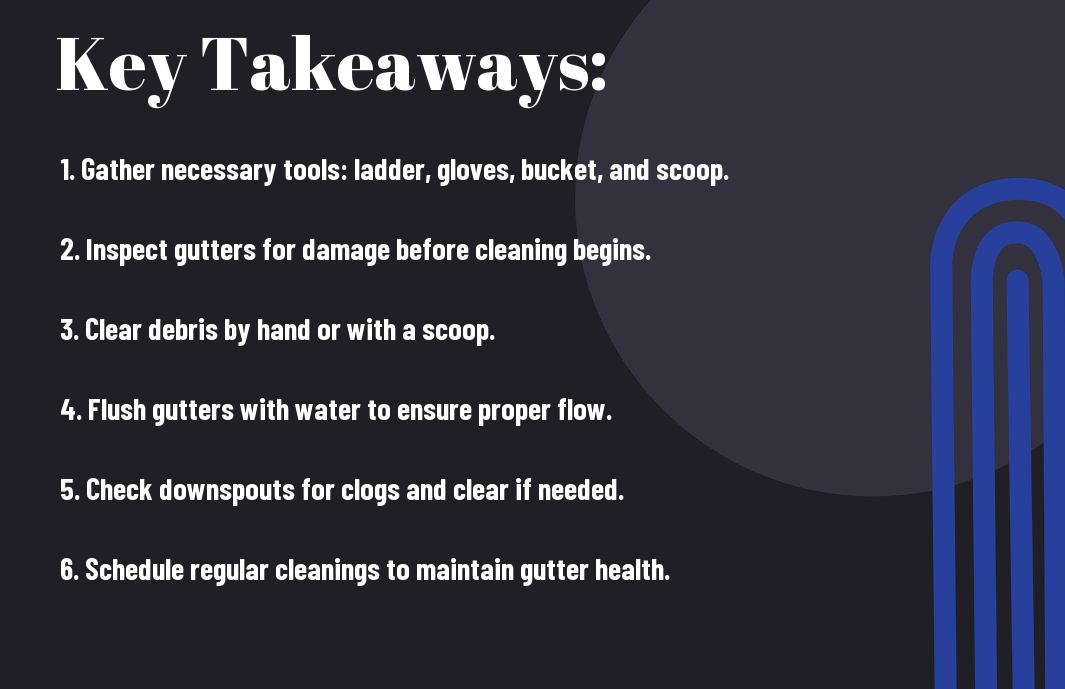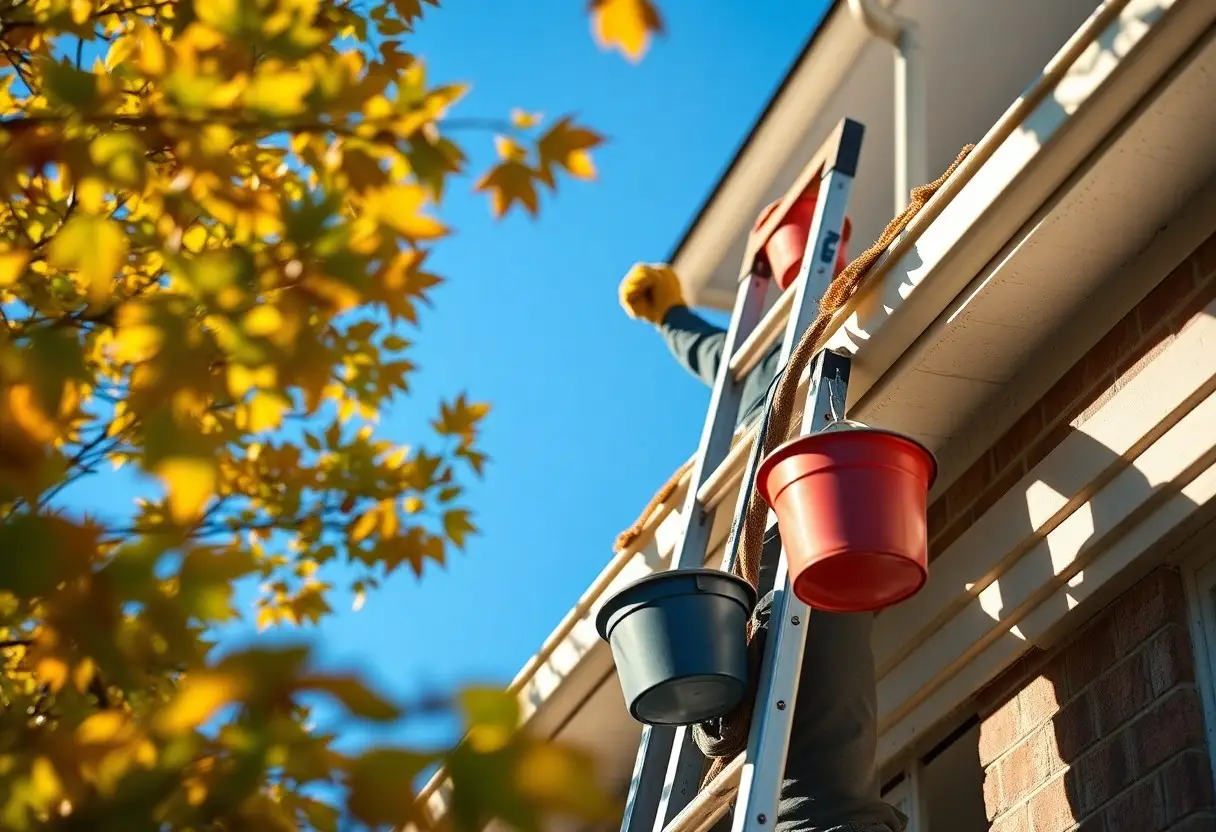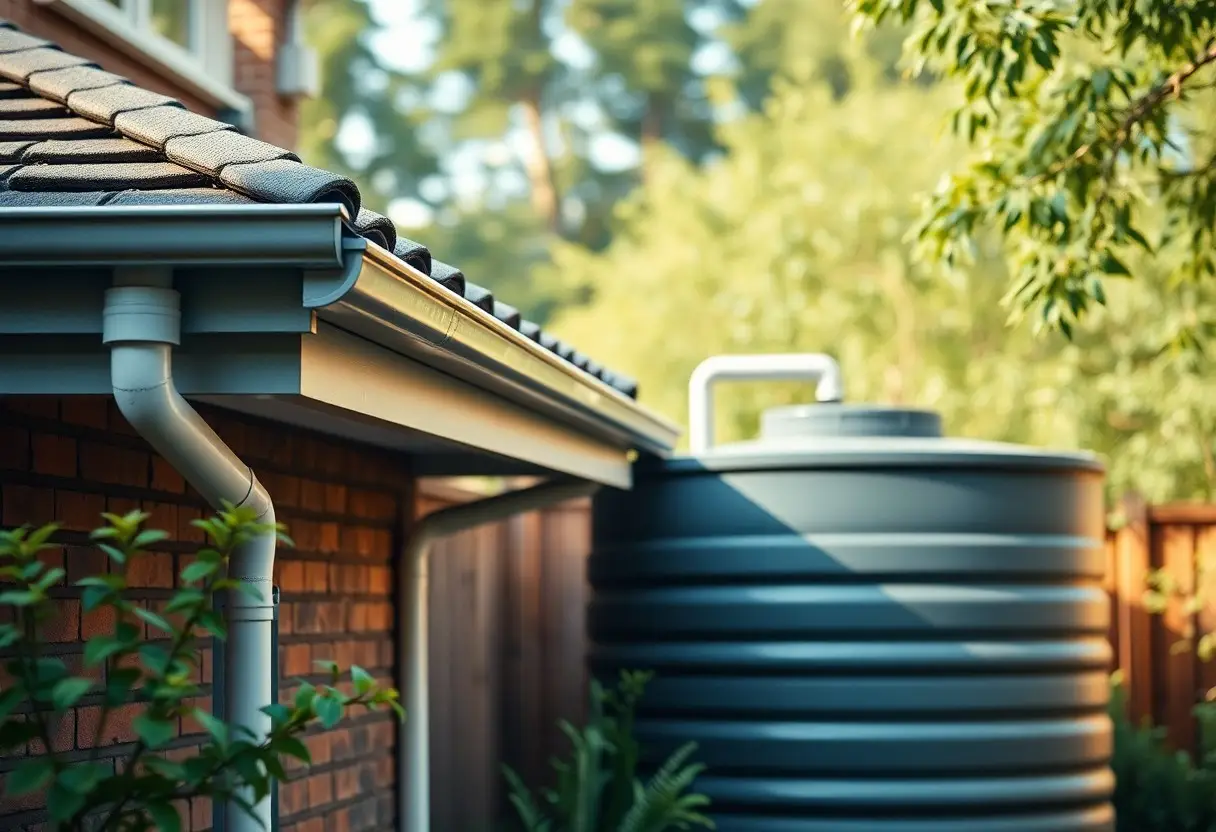You may not realize it, but proper gutter cleaning is important for maintaining your home’s integrity and preventing water damage. Clogged gutters can lead to serious issues, like flooding and mold growth, which can be costly to repair. Fortunately, cleaning your gutters doesn’t have to be a daunting task. In this blog post, you will discover 8 simple steps to efficiently clear your gutters and keep your home safe and sound. Equip yourself with the right tools, and you’ll find that gutter cleaning can be a straightforward and rewarding part of your home maintenance routine.
Key Takeaways:
- Regular maintenance is vital: Establish a routine schedule for gutter cleaning to prevent clogs and water damage.
- Safety first: Always use proper safety equipment, such as sturdy ladders and gloves, and consider enlisting help for difficult spots.
- Know your tools: Familiarize yourself with the necessary tools, like a trowel, bucket, and garden hose, to simplify the cleaning process.
Importance of Gutter Cleaning
The significance of regular gutter cleaning cannot be overstated, as it plays a vital role in maintaining your home’s integrity. Clogged gutters can lead to a series of problems, such as water overflow, foundation damage, pest infestations, and even mold growth. By ensuring your gutters are clear, you not only protect your property but also preserve its value over time. Staying proactive with this maintenance task will save you from costly repairs and headaches in the future.
Preventing Water Damage
The primary function of gutters is to direct rainwater away from your home, preventing water from pooling around the foundation. When gutters are clogged, rainwater can overflow and seep into the ground surrounding your house, leading to potential flooding in basements and damage to your foundation. Keeping your gutters clean is vital to safeguarding your home from serious water damage.
Health and Safety Concerns
An unclean gutter system can pose several health risks. Clogged gutters can harbor mold, mildew, and pests, which can affect your family’s health. The moisture buildup can also create an environment for insects, such as mosquitoes, to breed, increasing your exposure to diseases. Maintaining clean gutters contributes to a healthier living environment for you and your loved ones.
For instance, if you neglect gutter cleaning, you may find your gutters filled with stagnant water, attracting mosquitoes and other insects, which can pose serious health risks. Additionally, mold and mildew thrive in damp environments—not only affecting your gutters but potentially entering your home, resulting in respiratory problems and allergies. Ensuring your gutters are regularly cleaned will create a safe and healthy atmosphere while minimizing the chances of encountering such dangerous conditions.

Tools Needed for Gutter Cleaning
Some of the vital tools you will need to effectively clean your gutters include a sturdy ladder, a gutter scoop, and a bucket. Having a quality garden hose with a spray nozzle can aid in flushing out debris. Additionally, wearing gloves can protect your hands from sharp objects and grime found in your gutters. With the right tools at your disposal, you’ll find that gutter cleaning can be a manageable task.
Essential Tools
Any homeowner should invest in a few vital tools to streamline gutter cleaning. A reliable ladder, a gutter scoop, and a bucket will help you remove debris efficiently. Including a garden hose with a spray nozzle for rinsing out the gutters ensures a thorough job, leaving your gutters clear and functional.
Safety Equipment
Safety is paramount when cleaning gutters. Equip yourself with safety goggles to protect your eyes from debris, and wear sturdy gloves to shield your hands. Using a hard hat can also be beneficial, especially if you are working in an area with overhead branches or potential hazards.
Cleaning your gutters is much safer when you use the right safety equipment. Always wear high-quality gloves to protect against sharp edges and grime, and consider goggles to prevent dirt and debris from getting into your eyes. If you are working in areas with potential falling objects, don a hard hat to safeguard yourself against injuries. Following these safety measures can make your gutter cleaning experience much more secure and enjoyable.
Step-by-Step Gutter Cleaning Guide
Not all gutter cleaning methods are the same; knowing the right steps can simplify the process. Follow this step-by-step guide to ensure your gutters are clean and functioning properly.
| Step | Action |
|---|---|
| 1 | Preparing Your Workspace |
| 2 | Removing Debris |
| 3 | Flushing the Gutters |
| 4 | Inspecting for Damage |
Preparing Your Workspace
Behind every effective gutter cleaning is a well-prepared workspace. Gather all the necessary tools including a sturdy ladder, gloves, a trowel, and a bucket. Ensure your work area is free from obstacles and that your ladder is stable to avoid accidents, giving you peace of mind while you perform this necessary maintenance task.
Removing Debris
Against the natural elements, dirt and leaves accumulate in gutters. Start by using your hands or a trowel to scoop out the debris. Place it in a bucket or garbage bag to keep your work area tidy, ensuring you can easily dispose of the waste afterward.
But, it’s important to be thorough during this step. Look for clumps of leaves, twigs, and other waste that can cause blockages. Make sure to clear the entire length of the gutter, paying special attention to corners and downspouts, as these areas often trap more debris and require additional effort.
Flushing the Gutters
On completing the debris removal, it’s time to flush the gutters. Use a garden hose to run water through the gutters, checking that it flows freely through the downspouts. This step helps to clear any remaining dirt and ensures your gutters are completely clean.
Gutters should run smoothly after flushing. If water doesn’t drain properly, you may have a blockage further along the system. Continue to push water through until the downspouts flow clear, often easing further obstructions and keeping your gutter system in top shape.
Inspecting for Damage
One of the final steps in the cleaning process is inspecting for damage. Look for rust, holes, or sagging sections, as these issues can lead to significant problems in the future if left unaddressed.
For instance, you might discover small pinholes that can be easily patched before they grow into larger issues. Regularly checking for these signs allows you to maintain your gutters and ultimately protect your home from water damage.
Frequency of Gutter Cleaning
After assessing your property’s unique conditions, the general guideline for gutter cleaning is at least twice a year. Spring and fall serve as ideal times for this maintenance task, as they help keep your gutters clear from debris that can cause water damage. If you live in an area with heavy vegetation or frequent storms, you may need to increase the frequency to ensure optimal performance.
Seasonal Considerations
With each season bringing its own challenges, your gutter cleaning schedule should adapt accordingly. In the fall, leaves and twigs can clog your gutters, necessitating more frequent cleaning. Conversely, in spring, pollen and small buds may contribute to blockage. Tailoring your maintenance to seasonal changes will help protect your home’s foundation and landscape.
Environmental Factors
Frequency of cleaning should also consider the environmental factors present in your area, such as:
- Tree proximity: Trees near your home can drop leaves and debris.
- Weather patterns: Heavy rain or snow increases the chance of debris accumulation.
- Wildlife activities: Birds and rodents may nest and obstruct gutters.
Recognizing these environmental factors will help you determine when to adjust your gutter cleaning schedule.
It is vital to factor in your home’s unique environment when planning your gutter cleaning routine. For example, homes surrounded by numerous trees may require cleaning after each storm or high winds, while homes in drier areas may manage well with less frequency. Additionally, local wildlife can introduce debris if they decide to make a home in your gutters. By remaining vigilant and proactive, you can prevent excessive buildup that leads to costly damages. Recognizing the signs of potential issues will empower you to maintain your gutters effectively.
DIY vs. Professional Cleaning
Many homeowners face the decision between tackling gutter cleaning themselves or hiring a professional service. While DIY may seem like a cost-effective solution, it’s necessary to weigh the benefits and challenges against the expertise and safety that professionals offer. Understanding both options can help you make an informed choice tailored to your specific needs.
Pros and Cons of DIY
Below is a quick overview of the pros and cons when considering DIY gutter cleaning:
| Pros | Cons |
| Cost-effective | Time-consuming |
| Flexible schedule | Requires physical effort |
| Personal satisfaction | Risk of injury |
| Control over cleaning methods | Limited expertise |
| Access to your own tools | Possible incomplete cleaning |
When to Hire a Professional
Across various situations, hiring a professional might be your best option to ensure safe and thorough gutter cleaning. If you find yourself hesitant about heights, lacking appropriate equipment, or facing a clogged gutter system that seems beyond your experience, enlisting a professional can provide peace of mind.
The decision to hire an expert can be driven by factors such as the height of your home, a history of serious clogs, or extensive debris accumulation. Professional cleaners are equipped with tools and techniques for efficient cleaning and addressing hard-to-reach areas. Moreover, their experience minimizes the risk of personal injury or home damage, ensuring your gutters remain clear without the worry of hazardous tasks. Prioritizing your safety and the integrity of your home can lead to a more satisfying outcome.

Maintenance Tips for Clean Gutters
Unlike many homeowners believe, maintaining clean gutters doesn’t have to be a daunting task. Regular upkeep can prevent serious issues for your home. Here are some effective maintenance tips:
- Schedule seasonal cleanings.
- Inspect your gutters frequently for debris.
- Trim overhanging branches to reduce leaf buildup.
- Ensure downspouts are securely attached and clear.
- Check for proper drainage away from the foundation.
Recognizing the importance of these steps can lead to a healthier, more efficient gutter system.
Regular Inspections
Inspections are key to keeping your gutters in tip-top shape. Make it a habit to inspect your gutters at least twice a year, ensuring they are free of dirt and debris. Look for signs of leaks or sagging sections, which can indicate underlying issues. Early detection can save you time and money down the road.
Gutter Guards and Protection
Beside regular cleaning, consider investing in gutter guards for extra protection. These devices act as a shield, preventing leaves and debris from entering your gutters and reducing the frequency of cleanings. They come in various styles and materials, catering to different needs and budgets.
With gutter guards, you can significantly decrease the time spent on maintenance while enhancing the efficiency of your gutter system. They can help prevent clogs and potential water damage to your home. Additionally, by enabling water to flow freely, gutter guards can fend off issues like mold growth and landscape erosion. Investing in these protective measures not only secures your gutters but also promotes the longevity of your home’s structure.
How Can a Thorough Downspout Inspection Help with Gutter Cleaning?
A thorough downspout inspection is crucial for effective gutter cleaning. By following essential steps for inspecting your downspouts, you can identify clogs or damages that impede water flow. This proactive approach ensures gutters function properly, preventing costly repairs and maintaining the integrity of your home’s foundation.
To wrap up
Summing up, by following these eight steps for gutter cleaning, you can efficiently maintain your home’s drainage system. Regular cleaning not only prevents water damage but also enhances your property’s overall aesthetic. As you tackle this task, prioritize safety and utilize the right tools for the job. This proactive approach will help you avoid costly repairs and ensure your gutters function optimally, reflecting your dedication to home maintenance. Make gutter cleaning a routine part of your home upkeep to keep your roof and foundation protected.
FAQ
Q: What tools do I need for gutter cleaning?
A: For effective gutter cleaning, you primarily need a sturdy ladder to safely access your gutters. A garden trowel or scoop can help remove debris, while bucket bags or a bucket will assist in collecting the waste. Additionally, gloves are important to protect your hands from sharp materials. A hose with a spray nozzle can also be useful for flushing out the gutters after debris removal.
Q: How often should I clean my gutters?
A: It’s advisable to clean your gutters at least twice a year, ideally in the spring and fall. However, if you have overhanging trees, you may need to clean them more frequently to prevent leaves and branches from clogging the system. Regular maintenance can help avoid water damage to your home’s foundation and landscaping.
Q: What’s the best way to safely use a ladder during gutter cleaning?
A: To safely use a ladder for gutter cleaning, ensure it is placed on a flat, stable surface. Always maintain three points of contact—two hands and one foot or two feet and one hand—for stability while working. Do not lean too far to the side; instead, climb down and reposition the ladder as needed. Additionally, ask someone to hold the base of the ladder for added safety while you work.


